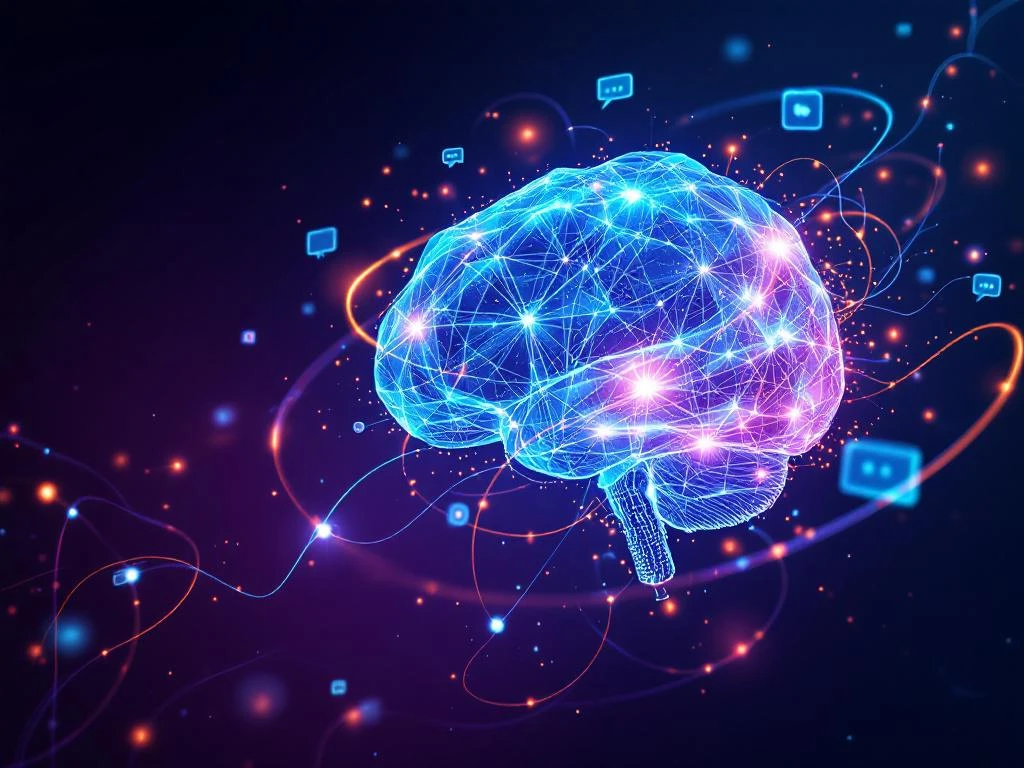AI conversations work through a sophisticated process where your text input gets transformed into mathematical representations, processed through neural networks, and converted back into human-readable responses. Modern AI systems use transformer architecture with attention mechanisms to understand context and generate relevant replies. This creates the illusion of understanding, though the AI is actually performing complex pattern matching based on training data.
What exactly happens when you talk to an AI?
When you type a message to an AI, your text gets broken down into smaller pieces called tokens, converted into numerical vectors, and processed through multiple layers of neural networks that identify patterns and relationships. The AI then generates a response by predicting the most likely sequence of words based on your input and its training data.
Think of it like having a conversation with someone who has read millions of books and remembers patterns from all of them. Your message triggers the AI to search through these learned patterns and construct a response that statistically fits best with what you’ve said. The process happens in milliseconds, but involves billions of calculations.
The AI doesn’t actually understand your words the way humans do. Instead, it recognises mathematical relationships between concepts. When you mention “weather,” the AI connects it to related concepts like “temperature,” “rain,” or “forecast” based on patterns it learned during training. This mathematical approach to language processing enables surprisingly natural conversations without true comprehension.
How does AI actually understand what you’re saying?
AI systems process your language through natural language processing (NLP), which involves tokenisation, semantic analysis, and contextual understanding. The AI breaks your sentences into tokens, maps them to high-dimensional vectors, and uses attention mechanisms to determine which parts of your message are most important for generating an appropriate response.
Tokenisation splits your text into manageable chunks – sometimes whole words, sometimes parts of words. The phrase “understanding AI” might become three tokens: “under,” “standing,” and “AI.” Each token gets converted into a numerical vector that represents its meaning mathematically.
The attention mechanism is crucial here. It helps the AI focus on relevant parts of your message while generating each word of its response. If you ask “What’s the weather like in London today?”, the attention mechanism ensures the AI pays more attention to “weather,” “London,” and “today” rather than less important words like “the” or “like.”
This is particularly relevant for conversational search, where AI systems need to understand not just keywords but the intent behind your questions. Modern AI can maintain context across multiple exchanges, remembering what you discussed earlier and building upon that foundation.
What’s the difference between rule-based chatbots and AI conversations?
Rule-based chatbots follow predetermined scripts and decision trees, responding only to specific keywords or phrases they’ve been programmed to recognise. AI conversation systems use machine learning to generate responses dynamically, adapting to context and handling unexpected inputs with flexibility that rule-based systems cannot match.
Traditional chatbots work like interactive flowcharts. They look for specific trigger words and follow branching paths to predetermined responses. If you say something outside their programmed scenarios, they typically respond with generic phrases like “I don’t understand” or redirect you to human support.
AI conversations, by contrast, can handle the unexpected. They generate responses based on patterns learned from vast amounts of text data. This means they can discuss topics they weren’t explicitly programmed to handle, make connections between different concepts, and maintain coherent conversations even when the topic shifts unexpectedly.
The flexibility extends to conversational search capabilities. While a rule-based chatbot might only respond to exact keyword matches, AI systems can understand synonyms, context, and implied meanings. They can answer “How do I fix this?” even without knowing specifically what “this” refers to, by using conversation history and contextual clues.
How do AI models learn to have conversations?
AI models learn conversational skills through supervised learning on massive text datasets, followed by reinforcement learning from human feedback (RLHF). They’re initially trained to predict the next word in sentences, then fine-tuned using human evaluators who rate response quality, teaching the AI to generate more helpful and appropriate replies.
The training process starts with feeding the AI enormous amounts of text from books, websites, and conversations. The AI learns to predict what word comes next in any given context. This might seem simple, but predicting the next word accurately requires understanding grammar, context, and meaning.
After this initial training, human trainers provide examples of good and bad responses. They might show the AI a question and several possible answers, ranking them from best to worst. The AI learns to favour response patterns that humans prefer, gradually becoming better at generating helpful, relevant, and appropriate replies.
The reinforcement learning phase is crucial for safety and usefulness. Human feedback teaches the AI to avoid harmful content, stay on topic, and provide genuinely helpful information. This process helps create AI systems that can engage in productive conversations rather than just generating grammatically correct but unhelpful text.
Why do AI conversations sometimes feel so human-like?
AI conversations feel human-like because of sophisticated attention mechanisms, context retention across multiple exchanges, and training on human-written text that includes conversational patterns, emotional expressions, and social cues. The AI learns to mirror human communication styles, including empathy, humour, and personality traits that make interactions feel natural.
The attention mechanism plays a crucial role in creating this human-like quality. It allows the AI to focus on different parts of the conversation history when generating each part of its response, much like how humans consider various aspects of a conversation before speaking.
Context retention makes conversations flow naturally. The AI remembers what you discussed earlier and can refer back to previous points, ask follow-up questions, and build upon shared understanding. This creates the impression of a continuous, meaningful dialogue rather than isolated question-and-answer exchanges.
Training data heavily influences conversational style. Since AI systems learn from human-written text, they absorb patterns of human communication including storytelling techniques, explanatory approaches, and even personality quirks. This makes their responses feel familiar and relatable, even though they’re generated through mathematical processes.
What are the limitations of current AI conversation technology?
Current AI conversation technology faces significant limitations including context window restrictions, hallucination issues where AI generates plausible-sounding but incorrect information, knowledge cutoff dates, and inability to truly understand meaning rather than just processing patterns. These systems also struggle with consistent personality, real-time learning, and distinguishing between reliable and unreliable information sources.
Context windows limit how much conversation history the AI can consider. Most systems can only “remember” the last few thousand words of your conversation. Beyond that limit, they lose track of earlier discussion points, which can make long conversations feel disjointed or repetitive.
Hallucination represents a major challenge. AI systems can confidently present false information that sounds completely plausible. They might invent statistics, create fictional historical events, or provide incorrect technical details while maintaining a convincing, authoritative tone throughout.
Knowledge cutoffs mean AI systems don’t know about recent events or developments. Their training data has a specific end date, after which they have no information. This limitation affects their ability to discuss current events, recent technological developments, or any information that emerged after their training concluded.
Despite these limitations, AI conversation technology continues advancing rapidly. Systems are becoming better at admitting uncertainty, citing sources, and maintaining consistency. However, users should always verify important information and understand that AI responses, while impressive, aren’t infallible sources of truth.
Understanding how AI conversations work helps you use these tools more effectively while recognising their boundaries. As this technology evolves, the line between human and AI communication continues to blur, making these systems increasingly valuable for everything from customer service to creative collaboration. The key lies in appreciating both their remarkable capabilities and their current limitations.





